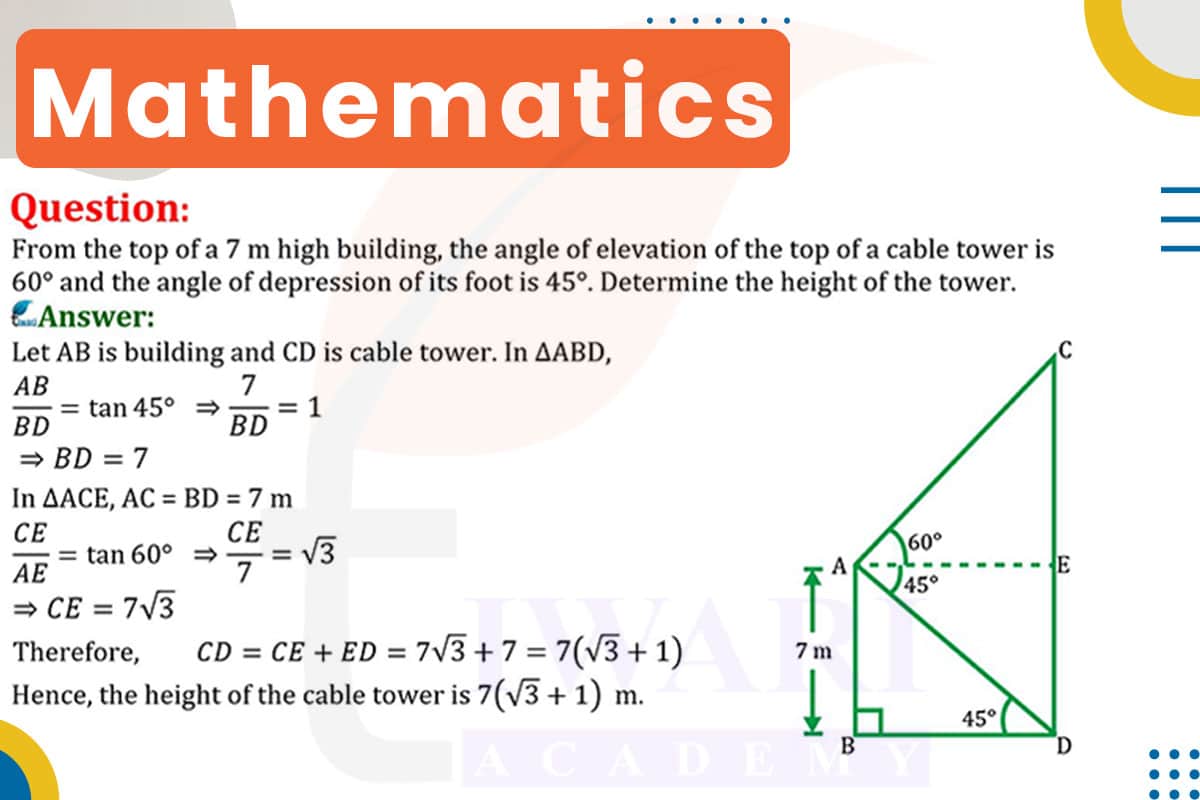To determine the height of the cable tower, we use trigonometry, considering two right-angled triangles formed by the line of sight from the top of the building.
Triangle with Angle of Elevation (60°): Let h be the height of the tower. The height above the building is h − 7 m. Using tan(60°) = √3, the equation is √3 = (h − 7)/d, where d is the horizontal distance.
Triangle with Angle of Depression (45°): Using tan(45°) = 1, the equation is 1 = /d. So, d = 7 m.
Substituting d in the first equation, √3 = (h − 7)/7. Solving for h, we get h = 7√3 + 7, which is approximately 19.12 meters. Therefore, the height of the tower is about 19.12 meters.

Let’s discuss in detail
Trigonometric Application in Height Determination
Trigonometry, a branch of mathematics, is crucial in various fields, especially in determining the heights of structures when direct measurement is impractical. The problem at hand involves a building and a cable tower, where the angles of elevation and depression are given. This scenario is a classic example of how trigonometry can be applied to solve real-world problems, particularly in construction and surveying. By analyzing the angles from a certain point, we can calculate the height of the tower, showcasing the practical utility of trigonometric principles.
Understanding the Problem: Building and Cable Tower
The problem presents a 7-meter-high building and a cable tower. From the top of the building, the angle of elevation to the top of the tower is 60°, and the angle of depression to the foot of the tower is 45°. The objective is to determine the height of the cable tower. This setup forms two right-angled triangles – one from the building’s top to the tower’s top and another from the building’s top to the tower’s base.
The Role of Tangent in Angle Measurement
In trigonometry, the tangent of an angle in a right-angled triangle is the ratio of the length of the opposite side to the length of the adjacent side. By applying the tangent function to the given angles of elevation and depression, we can calculate the height of the cable tower. The tangent function is particularly useful in scenarios where the height or distance of an object needs to be determined from a specific point.
Calculating the Horizontal Distance
First, we use the tangent function for the 45° angle of depression to find the horizontal distance between the building and the tower. The equation is tan(45°) = 1 = 7m/d, where d is the horizontal distance. Since tan(45°) = 1, it follows that the horizontal distance d is equal to 7 meters.
Determining the Height of the Cable Tower
Next, we apply the tangent function to the 60° angle of elevation to find the height of the cable tower. The equation is tan(60°) = √3 = (h−7)/7, where h is the height of the tower. Solving for h, we find h = 7√3 + 7 meters.
Trigonometry in Structural Analysis
The solution reveals that the height of the cable tower is approximately 19.12 meters. This example illustrates the practical application of trigonometry in determining the heights of structures, demonstrating its importance in construction, surveying, and urban planning. Trigonometry provides a reliable mathematical approach to solving problems where direct measurement is not possible, ensuring accuracy and efficiency in planning and design. This scenario underscores the significance of trigonometry in real-life applications, bridging the gap between theoretical mathematics and practical problem-solving.
Discuss this question in detail or visit to Class 10 Maths Chapter 9 for all questions.
Questions of 10th Maths Exercise 9.1 in Detail

